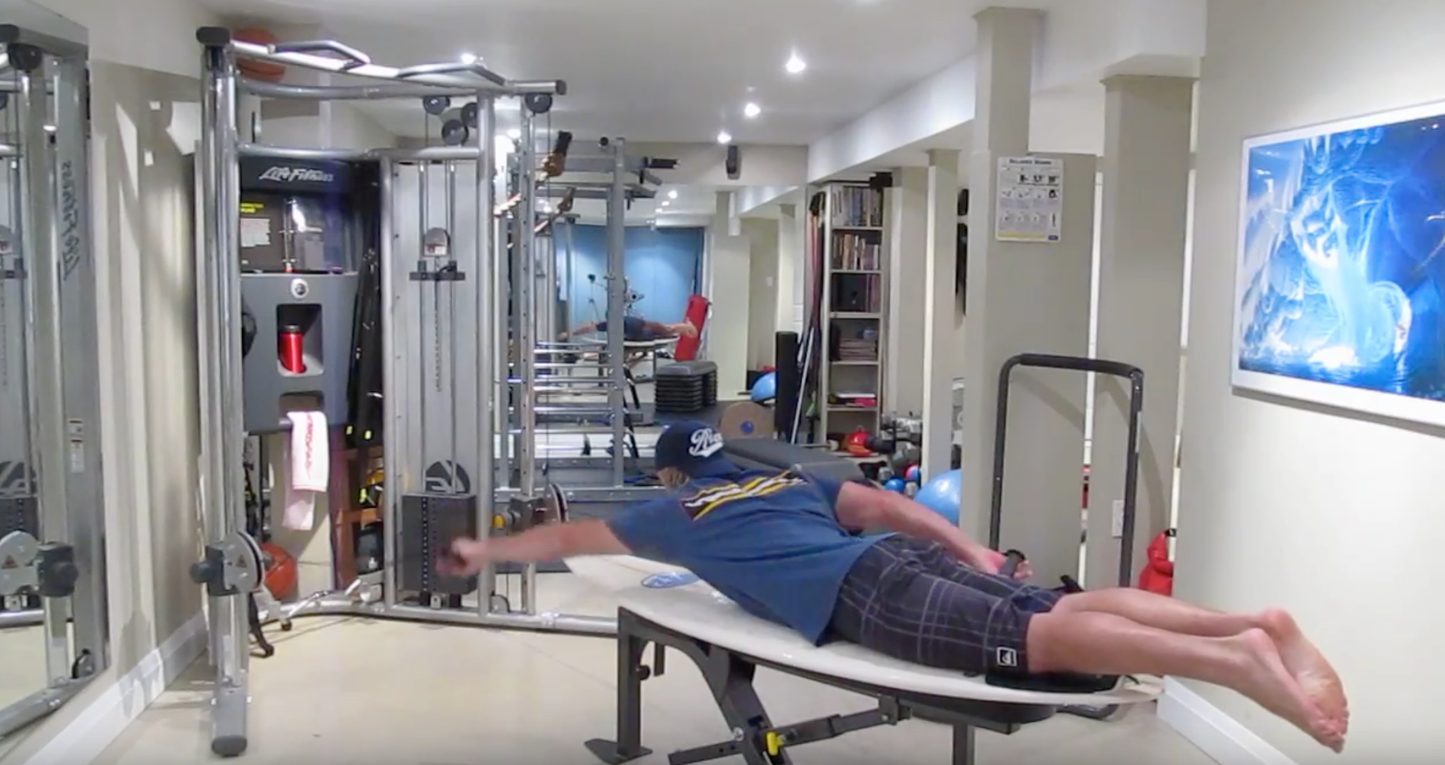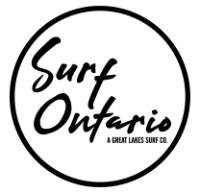
Below is a very detailed template and guide to help organize you training.
Following the guidelines and workouts within this template will improve your fitness and surfing ability whether you’re a novice or seasoned ripper. Surf Ontario can individualize this plan at our studio or in the comfort of your home. Exercise and flexibility selection is always based on a physical screening and past training background as everyone varies in strength, coordination, balance and flexibility.
 Below is a more detailed explanation of each phase plus we’ve included a few sample workouts and a video.
Below is a more detailed explanation of each phase plus we’ve included a few sample workouts and a video.
Rationale for Seasonal Training
The above chart outlines the annual plan for a lake surfer, however this could be manipulated to suit any surfer’s needs depending on their peak swell period. Spring and Summer tend to be your preparatory phase as this is the time where we have less consistent waves and more time to work on our dry land conditioning. Conversely, Fall and Winter are the conversion and peak phase (Competition) where the focus is on surfing your best, maintaining your training and reaping the rewards of your hard work. Although training varies depending on the time of year, it should be noted that core work and injury prevention exercises, such as those for the shoulder, are completed all year long.
PHASES & STRENGTH DEFINED
Preparatory Phase I & II (April – August & November – December)
AA-
This is the beginning phase of training for athletes and beginners into fitness. Adaptation prepares the joints, ligaments, tendons and muscles for further dynamic training under increased load. The focus is on core stability, postural improvement and muscular balance through corrective exercise. The body is used in full and there is a lot of variety in this phase to train your body with different angles. The exercises are not surf specific at this stage; the emphasis is on injury prevention and preparing a strong foundation for heavier lifting and more dynamic surf specific training.
Circuit training is best for this phase, combining 9 to 12 different exercises back to back with 2 to 3 sets per exercise. There is minimal rest between each exercise and the repetition range is 12 to 20. This phase can be as short as 4 weeks or as long as 8 weeks depending on your fitness level and condition, but it must occur at least twice during the year.
AA-
Dynamic Surf Style Warm-
Strength Training Workout: 3 Sets, 12-
- Body Weight Squats
- Push Ups
- Pull Ups
- Multi-
Directional Lunges - Wood Chops Low to High
- Seated Row
- Strict Glute Kick Backs
- Side Plank & Prone Plank
- Prone Cobra
Stretching: Stretching protocol is based on ongoing physical assessments specific to the individual.
S - 6 = Strength Training for a 6 Week Cycle 3 times per week.
This type of lifting trains the prime movers of surfing to be extremely strong. The central nervous system and muscles are fully recruited in heavy lifts of 80% to 95% of a one repetition maximum. Higher rest intervals, more sets and lower rep counts characterize this phase. Two, three-week cycles of lifts obtain the best results using a step loaded program. When lifting using a step loaded program with fluctuating intensities, it allows for recovery and great gains in strength without added bulk; exactly what a surfer needs.
Increase strength on stable and unstable surfaces and perfect technique on all exercises. This phase combines strength training with core and balance training. Conventional lifts are used on unstable surfaces such as the Indo balance board trainer or the Swiss ball. Light Plyometric training is maintained to ensure cat-like reflexes.
Perturbations to balance are used to mimic adjustments needed during your ride. For example, when you’re riding in a barrel on your surfboard and the wave is parting your hair or smacking your shoulder, this would be a perturbation. Barrel riding can be imitated by the trainer by pushing the trainee who is standing on an unstable surface, such as a Swiss ball.
Step Loading Bench Press Example:
Low Week #1 – 80% or 5-7 reps at 185 lbs Low Week #4 – 80% or 5-7 reps at 195 lbs
Medium Week #2 – 90% or 3-4 reps at 205 lbs Medium Week #5 – 90% or 3-4 reps at 215 lbs
High Week #3 – 95% or 2-3 reps at 225 lbs High Week #6 – 95% or 2-3 reps at 240 lbs
S-6 Maximum Strength Sample Workout:
Dynamic Surf Style Warm-up: 8 Minutes
Strength Training Exercises: 5-6 sets, Rest Interval 3-5 minutes, Reps 3-4

Core Strength Maintenance – 15 Minutes
Stretching: Stretching protocol is based on ongoing physical assessments specific to the individual
P – 2 = Power Two Weeks. 2 Times per week.
Power Phase: Jump higher, improve reactivity and explosiveness.
What does this mean to a surfer?
- Insane core strength and reflexes
- Outstanding balance
- Decreased chance for injury
- Explosive turns and powerful carving
- Increased efficiency and enjoyment while riding – launch and land airs!
Previous hard work and strength gains are converted to useful power to get you the most benefit on the wave. Training exercises become even more dynamic and challenging. Heavier plyometrics are utilized as well as other power lifts, from power cleans to Kettlebell snatches.
Sample Exercises:
- Depth jumps
- Hang cleans
- Push press on Indo board
- Plyometric push-ups off 2 Swiss balls
- Kettlebell Clean and Press
Try 2 – 3 sets, 6-10 reps per exercise & 60-120 seconds rest
M.E. = Muscular Endurance. 3 times per week
This phase of training takes strength gained and turns it into useable muscular endurance. Training loads are low enough (30-50%) that exercises are executed for longer duration and higher repetition counts. The surf paddling movement is practiced and incredible results are realized. Getting caught inside will never be as tough as it used to be!
M.E. of Medium Duration Sample Workout:
Dynamic Warm-up – 8 Minutes
Injury Prevention - Shoulder Stability – 5 Minutes
Prone Surf Paddling with Cables or Resistance Tubing*:
Variation #1: 45 seconds on, 15 seconds rest. 25 sets.
Variation #2: 20 seconds on, 10 seconds rest. 50 sets.
Variation #3: 4.5 Minutes on, 30 seconds off. 5 sets.
Check out Mike’s video demonstration:
*Timing of your sets can be easily monitored using an interval trainer application on your smart phone or by using a Gymboss. Please visit www.Gymboss.com or search for Impetus trainer on your phone to download the app.
Core Strength Maintenance – 5 Minutes
Stretching & Cool Down
Competition Phase I & II (September – October & January - February)
This is where all your hard work from the Spring and Summer truly pay off. Training is tapered down so your muscles rejuvenate and give you all the response you need paddling and riding the waves.
Less dry land work is needed as you’ll be spending much more time on the water. For example, you’ll need to put in about half the muscular endurance work specific to paddling because you’ll be surfing instead!
Mnt – Maintenance
The maintenance phase of training is exactly as it sounds - maintaining your base of strength and power throughout the most important part of your season. Muscular strength is lost up to 10% in the first week of detraining so it’s important to continue lifting while the waves are pumping. Strength and power workouts are cut down to once or twice a week, and though set counts are cut in half, the load should remain the same. The goal in this phase is to simply keep your muscles stimulated enough as to not experience significant detraining.
Transition 3-4 weeks
During the transition period you’ll still surf and do the odd workout; however training isn’t as regimented as the rest of the year so you can have a physical and mental break to prepare for the next season. Snowboarding, tennis, basketball or other sports can be played to mix things up so your motivation for the next season will be high.
Cardio
This section of the table explains the energy systems trained. 02 implies aerobic cardio training which could be running, rollerblading, or stand up paddling. Anaerobic is higher intensity training such as interval running, hill running or skateboarding. Training cardio will improve your overall fitness and capacity to surf longer sessions without fatigue. I’d recommend two to three bouts of 30 minutes per week throughout the season. The order of which appears first in the table dictates the emphasis you should put in your training. For example, if anaerobic is above 02 cardio, then anaerobic training should have two sessions per week versus one session per week cardio.
Skill
The skill portion of the table is where you practice your surfing, or use other implements such as the skateboard or stand up paddleboard (SUP) to work on your surfing skills. When the surf is up, you’ll spend a lot of time on your surfboard, however, when it’s down, you’ll spend more time on your skateboard and SUP. Carver skateboards are a great tool you can use on dry land to improve your wave riding ability.
Nutrition
All training would be for not without the proper fuel before, during and after your exercise. Check out BioSteel for your customized nutrition needs.
We hope all the above information helps as a guide and inspires you to train year round. For more information on how to improve your surfing fitness, please email info@surfontario.com and we’d be happy to help you!
References
Bahr, Roald, and Lars Engebretsen. Sports Injury Prevention. Chichester, UK: Wiley-Blackwell, 2009. Print.
Bompa, Tudor O. Periodization Training for Sports. Champaign, IL: Human Kinetics, 1999. Print.
Bompa, Tudor O. Periodization: Theory and Methodology of Training. Champaign, IL: Human Kinetics, 1999. Print.
McLeod, Ian. Swimming Anatomy. Champaign, IL: Human Kinetics, 2010. Print.
Salo, Dave, and Scott A. Riewald. Complete Conditioning for Swimming. Champaign, IL: Human Kinetics, 2008. Print.
